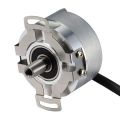1 - 1 of 1
Diameter
53 mm
53 mm
Resolution
Number of Pulses: 1024 ... 2048
Number of Pulses: 1024 ... 2048
Solid- / Hollow Shaft
Hollow 8 ... 12,7 mm, Solid 10 mm
Hollow 8 ... 12,7 mm, Solid 10 mm
Protection case
IP40
IP40
Interface
SinCos 1Vss
SinCos 1Vss
Approval
UL, CE
UL, CE
Features
Broad bandwidth of 500 KHz at full signal quality
Excellent immunity to interference
error compensation
Broad bandwidth of 500 KHz at full signal quality
Excellent immunity to interference
error compensation
1 - 1 of 1
